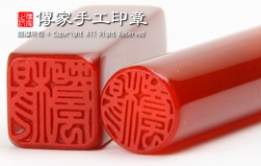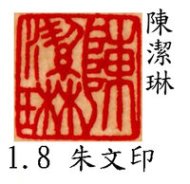My publishing rate may be very slow, but I have in fact been keeping fairly detailed notes of my life here in Taiwan. Today’s post is about something that happened way back in August – getting my first seal.
What is a Seal?
In America as well as most other Western countries, we typically sign our names as a form of identification. Each person’s handwriting is slightly unique, making it difficult for someone to pretend to be someone else. In East Asia, people sometimes sign their names by hand too, but another way of validating a document is by stamping a seal (印章 yinzhang in Chinese) on it. A seal is also sometimes called a “chop”. A seal works just like any other stamp, producing a red-and-white square image with the bearer’s name in Chinese characters.
A wide variety of seals
Seals have been used since ancient times in China, typically by the Emperor and government workers for official identification purposes. They were(and are) also used by artists to identify their artwork.
Here is a lovely painting of a plant. The red square in the corner is the artist’s seal – just like a signature!
Some seals have an intrinsic artistic value of their own. Here we see a seal belonging to a woman named Chieh-Lin Chen. Note that the Chinese characters to the right of the seal and the characters on the seal itself are the same Chinese characters, but the ones on the seal are written in an artistic calligraphy style no longer used for everyday purposes.
Seals in Taiwan
One of the first tasks I had to do in Taiwan was open a bank account. I came armed with my passport, resident card, school ID, and so on. However, I quickly hit a snag when the bank worker asked me to provide my seal in order to complete the account creation.
“A seal? Um, I don’t have a seal”
“What do you mean, you don’t have a seal?! You can’t open a bank account without a seal. Come back when you’ve got one.”
From the bank worker’s flabbergasted attitude, I could see that seals are very commonplace in Taiwan. Luckily, there is a shop that produces seals in the Shuiyuan Market located directly across from NTU. I went to that shop and was able to get my very own seal for about $2 USD.
My seal : Lin Li-Sha
As you can see, my seal is nowhere near as artistic as Ms. Chen’s, but it serves the purposes of identification for me at the bank.
In Taiwan, individual seals are rarely used outside of the bank, but official seals are used for almost everything. If you go to a hospital, register at school, pay a bill, etc. it’s highly likely there will be at least one or more seals on it to indicate that it has been approved by the relevant parties. In these cases, you personally wouldn’t need to stamp your seal, but the office in question would stamp their office’s seal.
A sample receipt with three (blurred out) seal stamps. Very common sight in Taiwan.
Note that when paying by credit card, however, Taiwanese people also just sign by hand.
Seals Around East Asia
I did a quick survey of my friends living in other parts of Asia. Seals are NOT commonly used in Hong Kong and Macau, where people prefer to sign their names by hand. The same is true for mainland China. In Japan, however, seals ARE commonly used for similar purposes and are known as “hanko”. Seals are also used in Korea, where they are called “dojang” and may be written in either Chinese characters or Korean letters (hangul). In both Japan and Korea, one must register their seal with the local government for it to be considered legally binding.
My Assessment of Seals
Personally, I think that seals were a great idea back in Ancient China. Most average people couldn’t even write Chinese characters, let alone forge a little stamp with intricate calligraphy on it. As long as you didn’t let anybody steal your seal, it’d be a great way of identifying yourself and proving your legitimacy.
Nowadays? The literacy rate in Taiwan is over 98%*, and virtually everybody can write their own name. Handwriting is very hard to imitate. On the other hand, it took me $2 and about 10 minutes to create a seal which could be imitated very easily with modern technology. I say it’s time to move on from using seals for individuals. They no longer provide more security than signatures. For government offices where people must constantly verify massive amounts of paperwork, I can definitely see how stamping on through would save time, though.
(*Keep this in mind, anyone who says “Chinese is impossible to learn to write”!)
Do you use seals where you live? What do you think is a better method of identity verification — seals or hand-written signatures?







